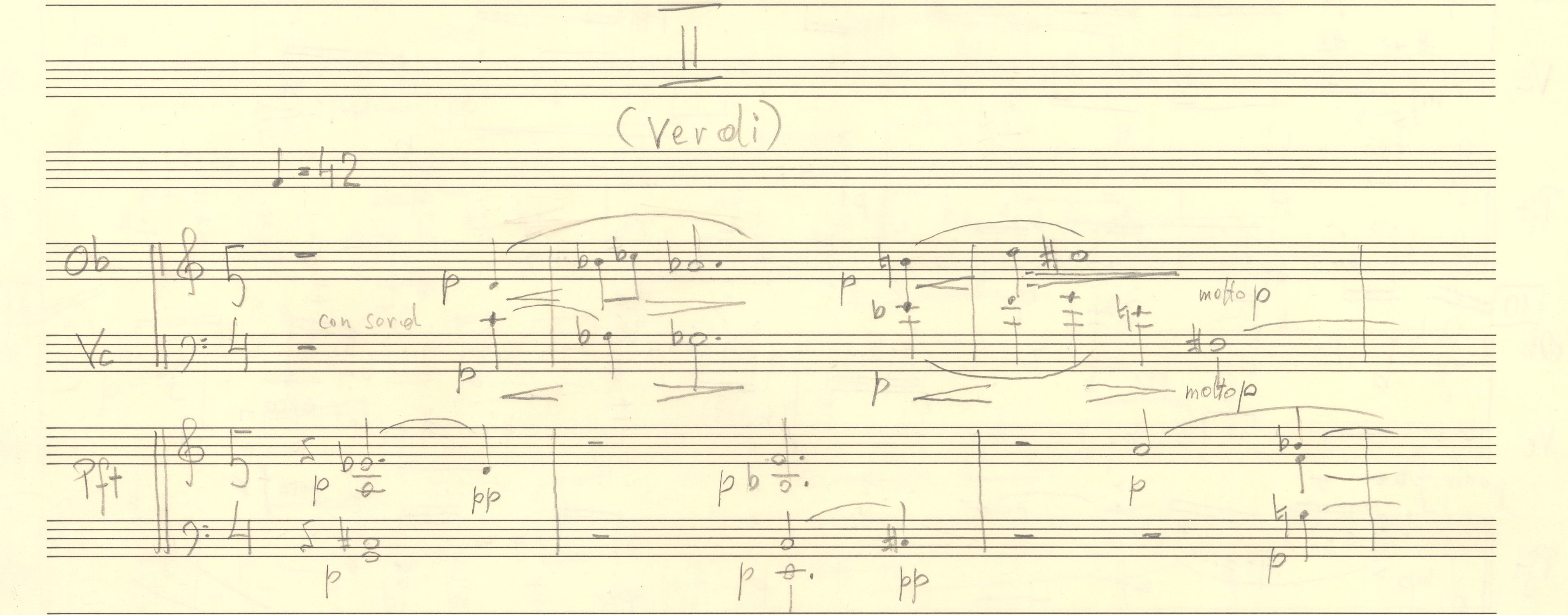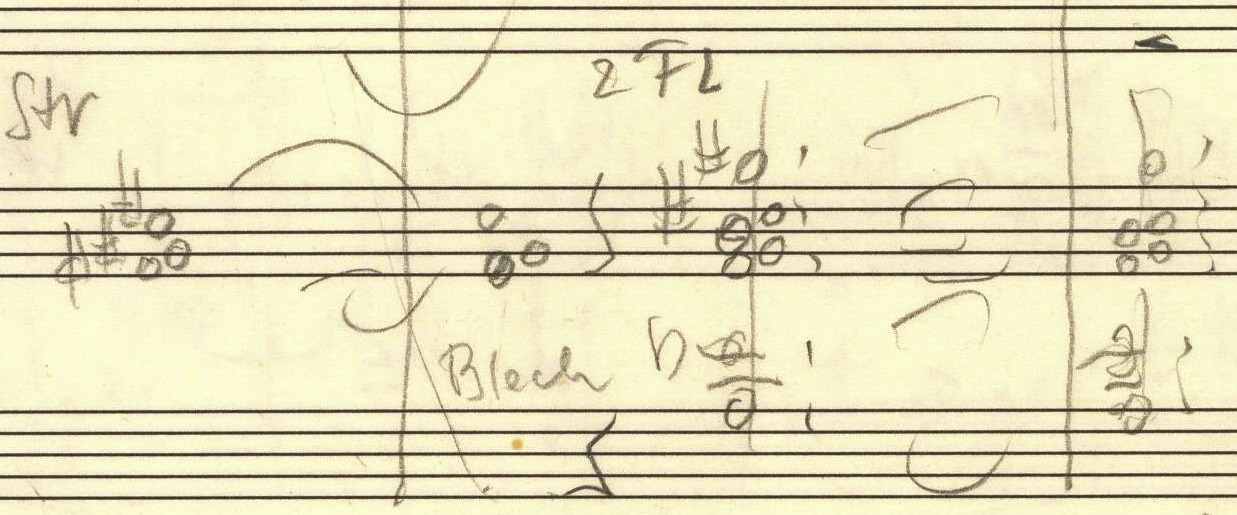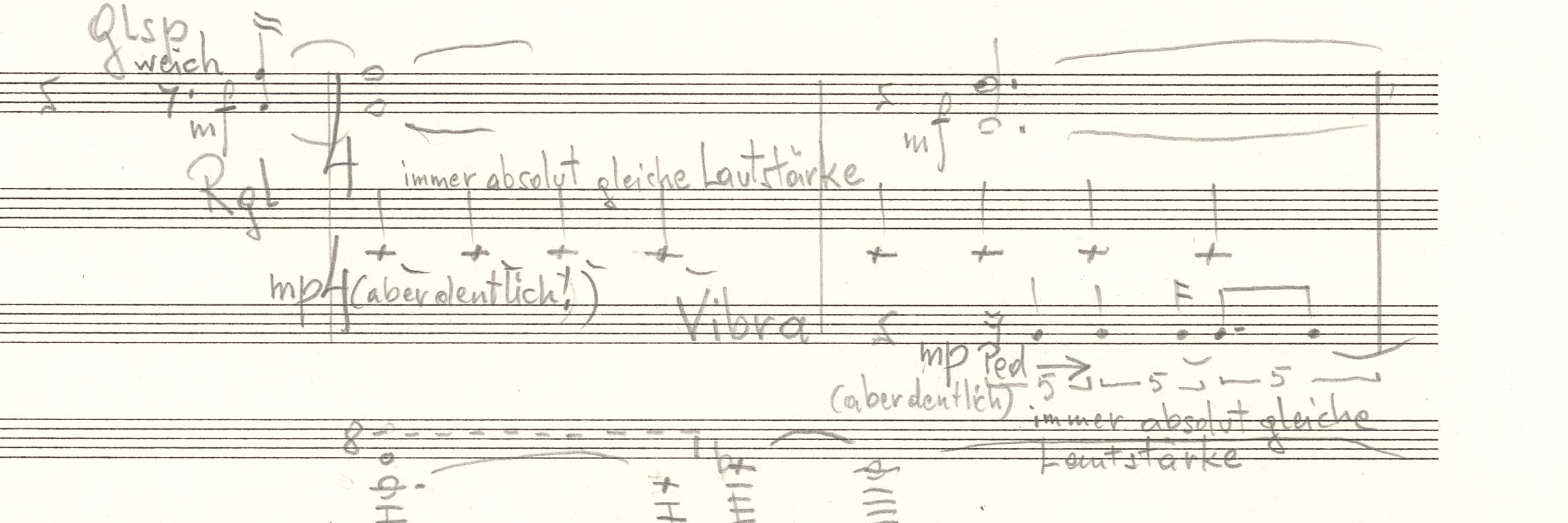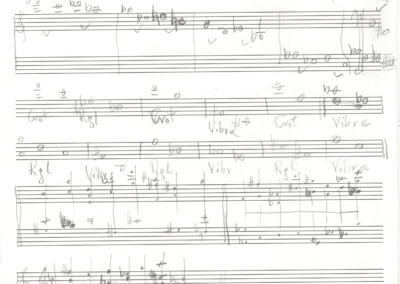Paraphrase über den Anfang der 9. Symphonie von Beethoven
An Overture?
Toccata, Ricercar und Passacaglia
Hymnus
Beethoven-Graffiti in Verona
The obstinate stare, rakish curls: Beethoven’s visage has long been iconic in popular culture. Symbolising intellectual genius, his image is everywhere, even on the streets. Graffiti artists around the world have paid tribute to the famous composer—not only in Verona (as in the image), but also in his hometown of Bonn.
Source: Richard Mc/Pixabay
“Joy, bright spark of divinity…”: These words will inevitably pop into the mind of anyone thinking of
Beethoven’s “Ninth”. But it is not only the euphoric ending that is legendary. The mysterious
beginning has also entered the annals of music history.
Beethoven, Symphony No. 9, I. Allegro ma non troppo, un poco maestoso, handwritten score, p. 1
Beethoven, Sinfonie Nr. 9, Beginn
Berliner Philharmoniker, Ltg. Herbert von Karajan, Produktion Deutsche Grammophon 2007 (Signatur: 442 9924)
The sounds at the beginning of the symphony emerge as if from behind a veil—unfathomable, enigmatic, elusive. The contrast to the radiant jubilation of the finale, the “Ode to Joy”, could hardly be any greater. In its time, the beginning of the Ninth was particularly spectacular. Although the introductions of some symphonies were gradual, most introductions were formidable and determined. The motto seemed to be: Let clarity prevail from the start instead of sneaking up to the action. But not so for the revolutionary Beethoven. The first bars can be seen as a musical counterpart to the Wanderer Above the Sea of Fog captured on canvas by Caspar David Friedrich in an expressive allegory of nature in 1818, six years before the premiere of Beethoven’s Ninth. But this music is more than an atmospheric haze of sound in the spirit of romanticism. Beethoven’s symphonic dawning was considerably beyond his time. His work inspired a great many composers—including Friedrich Cerha, who composed the piece Paraphrase in 2010.
Außenansicht

Caspar von Zumbusch, Beethoven monument, Vienna, 1880
Victor Wong/Flickr
Beethoven the revolutionary, the romantic, the humanist, the European, the philosopher, the genius … The list of attributes of and ideas about one of the greatest composers in Western music history could easily go on and on. The labels don’t always fit together, and it’s not uncommon for them to be contradictory. Even within musical circles there are very different assessments of the composer. In Beethoven’s adopted home of Vienna, two perspectives competed with each other in the twentieth century. Both viewpoints influenced Cerha, whose deep roots in Vienna Modernism are undisputed. Those who disagree with Beethoven’s reputation are the same people who oppose 12-tone music: Josef Matthias Hauer and Arnold Schönberg. Cerha became acquainted with their views of Beethoven, each coloured by their own aesthetics, early in the 1950s. Various individuals from Schönberg’s circle of students, including Erwin Ratz and Josef Polnauer, opened the door to a structural perspective for Cerha, allowing him to see the venerable composer “in a different light than previously”.Schriften: ein Netzwerk, Vienna 2001, p. 31 In an essay, he later reflected on “the intensive examination of Beethoven, initiated by Schönberg, by the entire Viennese school. The essential newness of his music, the concentration of his message in concisely formulated core motifs, and the development that emerges from them” pervades “their musical thinking”.Schriften: ein Netzwerk, Vienna 2001, p. 202
Hauer, whom Cerha visited several times in the early 1950s, advocated a completely different point of view: “In our conversations, he once said: ‘The musical mayhem all started with Beethoven.’ I was taken aback, but I soon realised that this attitude was quite consistent with Hauer’s approach. Beethoven’s evolutionary thinking”Schriften: ein Netzwerk, Vienna 2001, p. 32 stood in counterpoint to his ideal of low-contrast, flowing, static music.
Cerha moves between the poles of these two positions. Both the pro- and the anti-Beethovenian can be found in his work, evolutionary development, and celebrated stasis. The fact that Beethoven, perfector of Viennese classical music, became an object of reflection in later years, in particular the opening bars of the Ninth, further muddies the waters—after all, the original state that emerges here is not far removed from even Hauer’s musical opinions.
Brücke
There are few titles in Cerha’s oeuvre that state their musical goals as clearly as Paraphrase über den Anfang der 9. Symphonie von Beethoven. The subject is a retelling in the best sense of the word: music about music, and not just about any music, but about what is probably the most difficult symphonic colossus of the nineteenth century. The initial word of the piece’s name, “paraphrase”, wraps itself around the object of attention from different sides at the same time. Various artistic disciplines employ paraphrasing, always with a focus that references another work. In the linguistic field paraphrasing is known as a technique for citation, meaning to rephrase without directly reproducing. Other fields pursue similar aims. In literature, this can mean a retelling in a story or a poem, often to update outdated linguistic styles or to bring a text closer to new target groups; the numerous retellings of Homer’s Odyssey for children and young people, for example, are very popular. Paraphrasing in art and music is often comparatively less pragmatic and can mostly be understood as homage, sometimes even as parody. In painting, Pablo Picasso and Vincent van Gogh brought scenes painted by their predecessors (ranging from Rembrandt to Delacroix and Doré) into the present. Their own style of painting provided the necessary framework to create these time-conquering dialogues. Musical paraphrasings increased during the nineteenth century. Familiar melodies often became the subject of virtuoso embellishments, as in the well-known opera paraphrasing of Franz Liszt, set for the piano. He adapted, among other things, Verdi’s Rigoletto—and it may come as a surprise that a connection to Cerha can be found beginning here. In a chamber music counterpart to the orchestral Beethoven paraphrase, in 2011 Cerha composed Vier Paraphrasen for oboe, cello, and piano. This piece also contains (probably coincidentally) a citation of an aria from Rigoletto—and there’s more. One also hears Chopin and Dvořák, and the last movement is even “a mix of Johann Strauß, Offenbach, the Marseillaise, the Internationale, and Lohengrin” Joachim Diederichs: Friedrich Cerha. Werkeinführungen, Quellen, Dokumente, Vienna 2018, p. 152 Cerha is aware “that the inclusion of these pieces in [his] work represent a borderline case”. In the past, he had always avoided quoting too literally, so that references to other works of music appeared more as (sometimes vague) allusions, as in Langegger Nachtmusik I. Only a few pieces from the 1980s, including Eine Art Chansons and both Keintaten, showed his joy in referencing more widely to the outside.
Cerha, Vier Paraphrasen, II. (Verdi), handwritten score, 2011, AdZ, 00000164/9
Against my will, the beginning of the symphony haunted my head in the days to come—I could not get rid of it. Ever since I first heard the piece as a child, I have been particularly fascinated by it: the mysterious fifths and fourths over the tremolo, through to the powerful determination of the cadence at the end. This material began to reshape itself and proliferate like mycelium in my mind. The elements became increasingly varied, until their origins were unrecognisable. The dramaturgy of a piece slowly emerged from the nebulous ideas in my imagination—all without me writing down a single note. Finally, I accepted the assignment. I sat down and, in a frenzy, began to write down the notes of the piece for the first time.
Friedrich Cerha
Joachim Diederichs: Friedrich Cerha. Werkeinführungen, Quellen, Dokumente, Vienna 2018, p. 123
Riccardo Chailly, Friedrich Cerha, and the Gewandhaus Orchestra rehearsing the premiere of Paraphrase, Leipzig Gewandhaus 2011
Source: Gert Mothes, https://www.gertmothes.de/
Through Paraphrase, Cerha also revealed something of interest about the general creative process. As the description of the “proliferation” in his mind suggests, the “first version” of a work is “always the shortest. In the clean copy, a piece usually tends to expand, on the one hand because sections adjacent to one other often require the development of transitions, and on the other hand because the imagination does not stop with the first idea, and new doors keep opening up.”Joachim Diederichs: Friedrich Cerha. Werkeinführungen, Quellen, Dokumente, Vienna 2018, p. 123 Cerha’s homage to Beethoven is a prime example of this drive developing from a network of internal sounds.
Innenansicht
In a concert review, Tom Hellat describes the pairing of Beethoven’s symphony with Cerha’s related piece as “The Ninth with an overture”.Tom Hellat, „Die Neunte mit Ouvertüre“, Berliner Zeitung, 9 September 2014 However, the “opening” in the literal sense of the overture relates to more than just its constellation in the concert. It is inscribed much more deeply into the work. His aim is to make it possible to experience sound spaces beneath the surface, to open the act of listening in unimagined directions. At the same time, the role model to which Paraphrase refers is already an open sound space, one that consciously keeps almost everything in limbo.
If one understands Beethoven’s symphonic introduction as an opening to a modern world of sound in which the uncertain and the blurred are celebrated, then this resonates in many different ways. Something related can be found in romanticism—for example Richard Wagner’s famous Rheingold Prelude, grown from a primordial cell, or Anton Bruckner’s “Misterio” (the prelude to his Third), a nebulous field of sound with falling fifths and fourths. But Beethoven’s “original state” also provides suitable inspiration for Modernism. Cerha’s sculptural soundscapes, especially those in the Spiegel are related in spirit to the spatial and colour effects of the introduction to Beethoven’s Ninth. It is clear that the sound material here was more than worth working on.
The kinship of Paraphrase to its role model is emphasized by the orchestration. It “corresponds to that of Beethoven, although the three percussionists of course play other instruments.“Joachim Diederichs: Friedrich Cerha. Werkeinführungen, Quellen, Dokumente, Vienna 2018, p. 123 This expansion of the percussive apparatus is a flourish typical of Cerha, showing the multifaceted nature of the percussion he loves so much and often uses to add colour to the orchestra. In addition to timpani and bass drum (which are dominant in the Ninth), Paraphrase uses a large number of other instruments that only made their way into symphony orchestras after Beethoven’s time: antique cymbals (crotales), for example, and xylophone and tam-tam. These modern instruments change the character decisively. The percussion often leads the way through the deformed, post-symphonic soundscapes.
Cerha, Paraphrase über den Anfang der 9. Symphonie von Beethoven, handwritten score, instrumentation list, 2010, AdZ, 00000161/2
The invocation of Beethoven has a certain tradition in contemporary music. Fragments of his music appear in important collaged musical works from the late 1960s, for example in Bernd Alois Zimmermann’s Photoptosis, Luciano Berio’s Sinfonia, and Alfred Schnittke’s first symphony. Paraphrase, however, refrains from implementing such citations as directly as in those works. Instead, the echoes of the Ninth in Cerha’s own soundspace follow an almost dreamlike logic. Here and there, the music ties in to Beethoven, condensing individual elements or transforming them into barely recognisable new forms, so that discerning them is often more of a hunch than a certainty. The best way to gain insight into the relationships between the two works is through careful observation.
Cerha, Paraphrase über den Anfang der 9. Symphonie von Beethoven, Anfangsteil
Gewandhausorchester Leipzig, Ltg. Riccardo Chailly,
UA 6.10.2011,
CD: Edition Gewandhausorchester Vol. 4


timbres
Beethoven, Sinfonie Nr. 9, I, Autograf, 1. Seite, Hornstimme Farbe und Aura stehen in der Eröffnungsmusik der ‚Neunten‘ im Vordergrund. Diese ist über die gesamte Strecke aus nur zwei Tönen gebaut: Eine archaische, leere Quinte bildet die Basis für einen Klangteppich, den zunächst nur Streicher und Hörner auskleiden – ein zu Beethovens Zeiten kühner Beginn, verrät er doch rein gar nichts über die Tonart. Wohin es geht, bleibt vage. Das zitternde Tremolo der Geigen und Celli unterstreicht diese Ungewissheit. Schnell gewinnt der fragile der anfangs fragile Untergrundklang an Masse. Fast unmerklich treten neue Klangfarben hinzu: Klarinette, Oboe, dann Flöten und Fagotte, schließlich zwei weitere Hörner. Die Farben werden bei Beethoven summiert und in einen energetisch anwachsenden Prozess eingebettet, dessen zwangsläufiges Ende ihm zugleich einprogrammiert ist.
Motive
Beethoven, Sinfonie Nr. 9, I, Autograf, 1. Seite, Violinstimme Das akustische Feld wird in Beethovens Einleitung fast unmittelbar durch kurze motivische Einsprengsel belebt. Es handelt sich bei ihnen um fallende Quinten und Quarten, den urtümlichsten und zugleich neutralsten Intervallen überhaupt. Gesponnen sind sie aus dem Stoff des flächendeckenden Klangteppichs, in den sie sich gleichsam einfügen. Die miniaturartigen Motive werden ausschließlich von den Streichinstrumenten vorgetragen. Zunächst kommen sie „sotto voce“ („in gedämpftem Ton“) in den ersten Violinen zum Vorschein, dann werden sie in die Tiefe gereicht, zu den Bratschen und Bässen. Sind die Fallmotive anfangs noch großzügig auf der kontinuierlichen Fläche verstreut, so drängen sie sich in der Fortschreitung mehr und mehr zusammen. Es entsteht ein dichtes, bewegtes Tongeflecht.
Ausbrüche
Beethoven, Sinfonie Nr. 9, I, Autograf, 4. Seite, hohe Holzbläser Nachdem sich die Introduktion beständig mit Klang vollgesogen hat, schließt sich jener dramatische Kraftschub an, den so mancher von Beethovens Zeitgenossen sicherlich schon zu Beginn erwartet hätte (denkt man etwa an das brachiale Klopfmotiv der Fünften Sinfonie). Das aufgeschwemmte Orchester wird an dieser Stelle um Trompeten und Pauken bereichert. Alle Stimmen entladen sich, die meisten im Unisono. Ein kraftvoller Quartfall (gewonnen aus den mysteriösen Anfangsmotiven) löst sich schließlich in einen Akkord auf und lüftet damit das Rätsel um die Tonart: d-Moll wird zum Zentrum erkoren und mehrfach bestätigt, erst in einer figurativen Umspielung, dann mit gewaltigen Orchesterschlägen. Die Zweifel scheinen (fürs Erste) ausgehebelt zu sein – zumindest so lange, bis die Entwicklung nach dem ersten kollektiven Ausbruch kurzzeitig wieder zurück in die nebulösen Klangflächen führt, um sich erneut zuzuspitzen.
Klangfarben
Cerha, Paraphrase über den Anfang der 9. Symphonie von Beethoven, Skizze, 1. Seite, Akkorde Die ersten Takte der Paraphrase führen den beherrschenden Untergrundklang ähnlich vor wie das Beethoven’sche Vorbild. Ruhige, innerlich statische Klangflächen bestimmen das Geschehen. Anders als in der Sinfonie zieht sich nicht eine Farblinie kontinuierlich durch, um peu à peu angereichert zu werden, in Gegenteil: Die orchestrale Palette wird in zwei Bestandteile zerlegt. Wo in der ‚Neunten‘ Takt für Takt neue Farben des Streicher- und Bläserapparats miteinander verschmelzen, da knüpfen sie sich in der Paraphrase wie einzelne Glieder in Zeitlupe aneinander. Monolithische Farbblöcke wechseln zwischen dem schwerelosen, sphärisch rauschenden Flageolettregister der Streicher und einer pastellenen Mischung der Bläser. Die Harmonik, so Cerha, sei „aus einer Kette von absteigenden Quarten abgeleitet, die ja das erste Motiv in der 9. Symphonie bildet.“„aus einer Kette von absteigenden Quarten abgeleitet, die ja das erste Motiv in der 9. Symphonie bildet.“Zugleich spielen „diese Quartschichtungen für die Klanglichkeit kaum eine Rolle.“Simon Wildraut, „Postmodern? Friedrich Cerhas Paraphrase über den Anfang der 9. Symphonie von Beethoven“, in: Matthias Henke & Reinke Schwinning: Nach(t)musiken. Anmerkungen zur Instrumentalmusik Friedrich Cerhas, Siegen: universi 2021, S. 209-236, hier S. 230 Die Töne werden so zusammengeschoben, dass sich fein abgestimmte Cluster (Tontrauben) ergeben. Über eine geraume Zeit bilden sich die Silhouetten dieser Blöcke schemenhaft im Hintergrund ab. Nur sehr zögerlich gewinnen sie an Kontur und werden markanter wahrnehmbar.
Motive
Cerha, Paraphrase über den Anfang der 9. Symphonie von Beethoven, Skizze, 1. Seite, Quartmotive So wie es bei Beethoven nicht lange dauert, bis die typischen, fallenden Motivschnipsel den weiteren Verlauf lenken, so treten ähnliche Gestalten auch in der Paraphrase schnell hervor. „Cerha ließ […] die kargen Quint- und Quartfälle in seiner Fantasie spuken“ (so eine Rezension in der Wiener „Presse“).Wilhelm Sinkovicz, „Cerha legt Beethovens Neunter ein Fundament“, Die Presse, 23.10.2011, https://www.diepresse.com/703269/cerha-legt-beethovens-neunter-ein-fundament Diverse Schlaginstrumente rufen die charakteristischen Motive in Erinnerung. Es wechseln sich Crotales, Röhrenglocken und Vibrafon ab. Im Vergleich zum Sinfoniebeginn ist der Klangstrom jedoch ruhiger. Den metallischen Einsprengseln wird Zeit gewährt, um sich raumgreifend zu entfalten. Ihre funkelnde Klangaura entfaltet sich zunächst mit großer Ruhe. Nach und nach verdichten sich dann die Motive wie bei Beethoven (jeoch auf einer viel längeren Strecke). Dieser Prozess bezieht auch die Untergrundebene mit ein. Sind die statischen Klangflächen in den Streichern und Bläsern zunächst von den Fallmotiven entkoppelt, so vitalisieren sie sich mit der Zeit, bis sie selbst die Quartfälle teilweise imitieren. Cerha denkt die Beethoven’sche Einleitung an dieser Stelle weiter: Er begreift ihre Grundelemente als Ebenen, die in Wechselwirkung zueinanderstehen, ein kompositorisches Denken, das maßgeblich aus seiner Beschäftigung mit der Kybernetik rührt.
Ausbrüche
Cerha, Paraphrase über den Anfang der 9. Symphonie von Beethoven, Skizze, 5. Seite, Stimmgeflecht In Beethovens Sinfonie vergehen gefühlt nur Wimpernschläge, bis sich die große Klangentladung vollzieht. Von den ersten Tönen an läuft die Musik darauf konsequent zu. Anders bei Cerha: Seine Liebe zu großflächigen und sich behutsam entwickelnden Prozessen läuft auf eine beträchtliche Zeitdehnung hinaus. Das Spannungsverhältnis zwischen der Klangebene der Schlaginstrumente und jener der Streicher und Bläser beherrscht die Musik zunächst vollkommen. Prozesshaft bereiten die angeregten und durchaus lebendigen Klangflächen danach eine Eruption vor, die Beethovens gewaltige Kadenz paraphrasiert. Von plakativer Nachahmung ist die Entwicklung jedoch weit entfernt. Bezüge zur ‚Neunten‘ ergeben sich in einigen Schichten des sich auftürmenden Klangmaterials. Einzelne Instrumentengruppen lösen sich beispielsweise in unisono geführte Linien auf – eine Parallele zu Beethoven. Rudimente der zackigen Akkordbrechungen sind außerdem in einzelnen Stimmen (vor allem den Trompeten und Posaunen) zu vernehmen. Gleichfalls sind die Unterscheide eklatant: Cerhas Paraphrase spaltet sich in mehrere zeitgleich ablaufende Prozesse auf. Ab einem gewissen Punkt wandern im ganzen Orchester echoartig Tonwiederholungen umher, die gar an den dissonanten Finalanfang der ‚Neunten‘ denken lassen. Eine wilde Paukenpartie als überstilisiertes Relikt der Sinfonik des 19. Jahrhunderts schließt sich an, ehe hektische Klangfarbenwechsel schließlich wieder zur Beruhigung der Musik führen.
Cerha, Paraphrase über den Anfang der 9. Symphonie von Beethoven, sketch, T. 1–6, AdZ, 00000161/2
Interpreting Cerha’s Paraphrase as a mere retelling would be a disservice to the sheer inventiveness of his music. The piece links into Beethoven while maintaining a healthy distance: Individual threads of the symphony’s beginning are picked up and then stretched into an entirely new fabric. The alternation between enraptured, lyrical passages and those that are driving and energetic corresponds to the same dialectic that determines Beethoven’s introduction to the Ninth. However, Cerha’s story is told with a strong and personal voice. According to Riccardo Chailly, conductor of the premiere, “Beethoven appears like a shadowy figure in the night.“Walter Dobner, „Kunst nach Metronom“, Die Presse, 15 October 2011, https://www.diepresse.com/701268/kunst-nach-metronom While the references to him are initially rather clearly recognisable, they soften over time. The end of Paraphrase makes it clear how much Cerha’s own musical ideas overarch the source material. Wrapped in the transcendent mood of the beginning, the metallic percussion instruments reappear. And then, driven by Beethovenian fourths, something new emerges: a polyrhythmic drip, a signature of “late” Cerha.
Cerha, Paraphrase über den Anfang der 9. Symphonie von Beethoven, handwritten score, T. 207 ff. (drums), AdZ, 00000161/47
Cerha, Paraphrase über den Anfang der 9. Symphonie von Beethoven, Schlussteil (Ausschnitt)
Gewandhausorchester Leipzig, Ltg. Riccardo Chailly,
UA 6.10.2011,
CD: Edition Gewandhausorchester Vol. 4
Instead of emphasizing opposites, Cerha’s work with older music has always been about building bridges. Tradition should act as a doorway to the present, just as looking back should also reveal a way forward. Cerha’s bow to Beethoven can also be seen in this light. He “very much hopes that the gap between” Paraphrase and the Ninth “is not seen as an incurable rift between different things, but can instead be experienced as related music.“Joachim Diederichs: Friedrich Cerha. Werkeinführungen, Quellen, Dokumente, Vienna 2018, p. 123



















